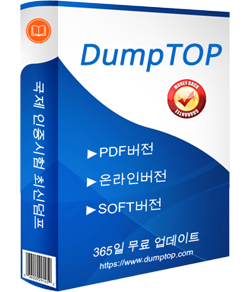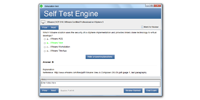간결한 내용
DEA-C02 덤프문제는 다년간의 다양한 시험에 대한 분석을 바탕으로, 시험문제의 주요 발전 경향에 따라 응시자가 직면할 어려움을 정면 돌파하기 위하여 전문가들이 자신만의 경험과 끊임없는 노력으로 제작한 최고품질의 시험자료입니다.다른 교육 플랫폼과 달리 SnowPro Advanced: Data Engineer (DEA-C02) 시험덤프는 오래된 문제는 삭제하고 새로운 문제는 바로바로 추가하여 덤프가 항상 가장 최신버전이도록 간결하고 눈에 잘 띄는 텍스트로 요약되어 있기에 덤프만 완벽하게 마스터 하시면 DEA-C02 시험패스는 더는 어려운 일이 아닙니다.
커리큘럼 소개
대부분의 분들에게 있어서 자격증 시험이 처음일 수 있으므로 자격증 시험과 관련된 많은 정보는 복잡하고 난해할수 있습니다. 하지만 자격증 취득 초보자들의 덤프공부 후기에 따르면 DEA-C02 덤프는 시험의 모든 출제범위와 시험유형을 커버하고 있어 덤프에 있는 문제와 답만 기억하시면 SnowPro Advanced: Data Engineer (DEA-C02) 시험을 쉽게 패스하여 자격증을 취득할수 있다고 합니다. DEA-C02 시험대비 덤프는 초보자의 눈높이에 맞추어 덤프를 사용하시는 분께서 보다 편하게 공부할수 있도록 엘리트한 전문가들의 끊임없는 연구와 자신만의 노하우로 최선을 다한 자료입니다.덤프의 도움으로 여러분은 업계에서 또 한층 업그레이드 될것입니다.
우리의 SnowPro Advanced: Data Engineer (DEA-C02) 시험 덤프 문제는 최고품질의 시험대비 자료입니다. 전문가들이 최신 실러버스에 따라 몇년간의 노하우와 경험을 충분히 활용하여 연구제작해낸 자료라 해당 시험의 핵심문제를 모두 반영하고 있습니다.DEA-C02 덤프로 시험을 준비하시면 시험패스는 더는 어려운 일이 아닙니다. DEA-C02 시험에서 출제 가능성이 높은 문제만 정리한 최신 버전 자료라 가장 적은 문항수로 모든 응시자가 효율적인 시험공부를 할 수 있도록 하고 부담 없이 한번에 DEA-C02 시험을 즉시 통과할 수 있도록 도와드립니다.
진정한 시뮬레이션 환경
많은 응시자 분들이 처음 자격증 시험에 도전하는 것이라 시험보실 때 경험 부족으로 인해 시험시간에 너무 긴장하여 평소 실력을 발휘하지 못하는 경우가 있습니다.이를 피면할수 있도록 미리 SnowPro Advanced: Data Engineer (DEA-C02) 시험과 비슷한 환경에서 연습하는 훈련을 통해 실제 시험에서 긴장을 완화시키는 것이 좋습니다. 저희는DEA-C02 실제 시험 시뮬레이션 테스트 환경에 해당하는 제품을 가지고 있습니다. 제품 구매후 자신의 계정에 로그인하시고 실제 시험 환경을 체험해 보시면 시험 환경에 적응되어 DEA-C02 시험보실때 문제 푸는 방법을 모색하는 시간이 줄어들어 자신감이 생겨 한방에 시험패스 가능할것입니다.
최신 SnowPro Advanced DEA-C02 무료샘플문제:
1. You are tasked with creating a Snowpark Java stored procedure to calculate a complex, custom rolling average for a time series dataset. This rolling average requires access to external libraries for statistical calculations. Which of the following steps are necessary to successfully deploy and execute this stored procedure?
A) Upload the JAR file to a Snowflake stage.
B) Grant the necessary privileges on the stage and the database to the role executing the stored procedure.
C) All of the above.
D) Package the Java code and all necessary external libraries into a single JAR file.
E) Create a stored procedure in Snowflake, specifying the fully qualified path to the JAR file in the stage, the handler class, and the return type.
2. Consider a table with columns and 'customer _ region'. You want to implement both a Row Access Policy (RAP) and an Aggregation Policy on this table. The RAP should restrict access to orders based on the user's region, defined in a session variable 'CURRENT REGION'. Users should only see orders from their region. The Aggregation Policy should mask order totals for regions other than the user's region when aggregating data'. In other words if someone attempts to aggregate ALL region's totals, the aggregation will only include their region. Which statements about implementing this scenario are true?
A) You cannot use session variables directly in Row Access Policies; you must pass the session variable as an argument to a user-defined function (UDF) called by the policy.
B) Using external functions in RAPs can introduce performance overhead, especially if the external function is complex or slow to execute.
C) The RAP should be applied first to filter the data, and then the Aggregation Policy will apply to the filtered data, only masking aggregated values within the user's region.
D) The Aggregation Policy is evaluated before the RAP, ensuring that even if users try to bypass the RAP by aggregating across all regions, the results will be masked appropriately according to 'CURRENT REGION'.
E) You can use the function within both the RAP and Aggregation Policy to control access based on user roles in addition to region.
3. A Snowflake table 'SALES DATA' is frequently updated via Snowpipe. Historical data is occasionally queried using time travel. You notice that time travel queries are becoming increasingly slow. Which of the following Snowflake features or techniques would BEST address this performance degradation?
A) Decrease the parameter for the 'SALES_DATA' table.
B) Increase the parameter for the 'SALES_DATX table.
C) Implement data clustering on a column that is frequently used in time travel query filters.
D) Periodically clone the ' SALES DATA' table to a separate historical table.
E) Create a materialized view that pre-computes the results of common time travel queries.
4. You are tasked with building a data pipeline using Snowpark to process sensor data from IoT devices. The data arrives in near real-time as JSON payloads, and you need to transform and load it into a Snowflake table named 'SENSOR DATA'. The transformation logic involves extracting specific fields, converting data types, and filtering out records based on a timestamp. Consider performance optimization for large data volumes. Which of the following approaches, in combination, would be MOST efficient for this scenario?
A) Employing Snowpipe to ingest the raw JSON data into a VARIANT column in a staging table, followed by a Snowpark DataFrame operation using 'functions.get' to extract and transform the data, and finally loading into 'SENSOR DATA'
B) Creating an external table pointing to the JSON data in cloud storage and using Snowpark DataFrames to read the external table, apply transformations, and load the result into 'SENSOR DATA'.
C) Using a Snowpark Python UDF to parse JSON and perform transformations, loading the result into a temporary table, and then merging into 'SENSOR DATA'.
D) Using a stored procedure written in Java to parse the JSON data and insert directly into the "SENSOR DATA' table.
E) Leveraging Snowflake's native JSON parsing functions within a SQL transformation step implemented as a Snowpark DataFrame operation, combined with a Snowpipe for initial data ingestion into a staging table.
5. You have a data pipeline that aggregates web server logs hourly. The pipeline loads data into a Snowflake table 'WEB LOGS' which is partitioned by 'event_time'. You notice that queries against this table are slow, especially those that filter on specific time ranges. Analyze the following Snowflake table definition and query pattern and select the options to diagnose and fix the performance issue: Table Definition:
A) Increase the warehouse size to improve query performance.
B) Create a materialized view that pre-aggregates the 'status_code' by hour to speed up the aggregation query.
C) Add a search optimization strategy to the table on the 'event_time' column.
D) Change the table to use clustering on 'event_time' instead of partitioning to improve query performance for range filters.
E) The table is already partitioned by 'event_time' , so there is no need for further optimization.
질문과 대답:
| 질문 # 1 정답: C | 질문 # 2 정답: B,E | 질문 # 3 정답: C | 질문 # 4 정답: A,E | 질문 # 5 정답: B,C,D |


 485 고객 리뷰
485 고객 리뷰





